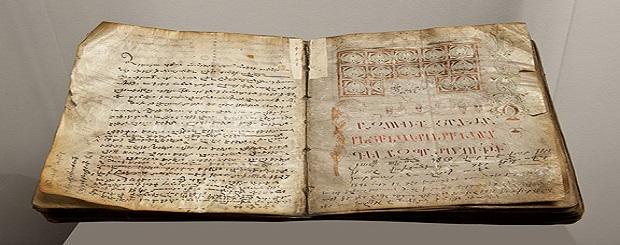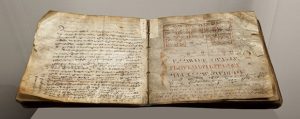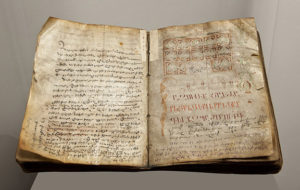
800-Year-old Garabed Gospel to be Digitized
JUNE 02, 2020 – ARMENIAN GENOCIDE – I REMEMBER AND I DEMAND:

The Armenian Museum of America in Watertown, Mass. announced the upcoming digitization of the most important piece in its collection–the 1207 Garabed Gospel. The Garabed Gospel was delivered by Museum staff to the Northeast Document Conservation Center earlier this year and the digitization process is slated to begin very soon.
This project is part of the museum’s ongoing effort to maintain and preserve in perpetuity an active program of collecting, conserving, and documenting Armenian artifacts, books, and publications.
The scribe Garabed created this extraordinary work in 1207 A.D, at the monastery of Surp Garabed near the town of Jurak during the reign of Levon I of Cilicia. It required eleven years to complete the book and the elderly scribe noted that he went blind during that period.
The book was given to priest Vartan, the donor’s ancestor, who returned with the book to his home in the town of Tomarza, where it remained for over 700 years passed down within one family lineage of priests (the Der Garabedian/Hazarshahian/Chorbajian family.) The name of each generation of priests is noted in the Gospel Book for over thirty-five generations. The Gospel Book escaped the death and destruction that many in the Der Garabedian family suffered in the Armenian Genocide.
The Garabed Gospel Book is made of 250 pages of goat skin, covered with leather-bound wooden covers. The text is in double columns in black ink with decorative figures on the pages edges in red ink. The artistic style is relatively crude, typical of the Cilician style. The larger size of the book is also typical of this early period. In the later mature Cilician style, Gospel books are often small enough to be carried in one hand, with refined delicate artwork.
This Gospel Book is the most important artifact in Museum’s collection. The scribe Garabed created this extraordinary work in 1207 A.D, at the monastery of Surp Garabed near the town of Jurak during the reign of Levon I of Cilicia. It required eleven years to complete the book and the elderly scribe noted that he went blind during that period. The book was given to priest Vartan, the donor’s ancestor, who returned with the book to his home in the town of Tomarza, where it remained for over 700 years passed down within one family lineage of priests (the Der Garabedian/Hazarshahian/Chorbajian family.)
As the possessor of the Holy Book, the Der Garabedian family was respected by both Armenians and Turks, and it was believed that no harm could fall upon the family. If one became sick, one would ask the family for “the blessing of the book” to cure their disease. A supplicant would rub a piece of bread or a rag on the Gospel Book. If the bread was eaten by the afflicted, or the rag was worn against their body, it was thought to cure the disease. The name of each generation of priests is noted in the Gospel Book for over thirty five generations. In the Armenian tradition a family holy book was considered a living member of the family. In 1915 the book was unable to save 150 members of the extended Der Garabedian family who were slaughtered during the Armenian Genocide, and the Gospel book was seized. The local family survivor, Garabed Hairik Der Garabedian, was forced to ransom back the book, his only other surviving family member.
One other family member, his nephew Krikor Der Garabedian, was working in America during the Genocide and has also survived. When Krikor traveled to France to get married in 1927, his uncle gave him the Gospel Book with instructions to pass it along to his own children. Krikor and his wife Baytzar had three daughters, but no daughter had children to continue the line. Concerned that the Gospel Book would become an orphan after 39 generations, the last surviving daughter, Julia Der Garabedian, entrusted the book to the Museum.

yerakouyn.com/2020/06/02/800-year-old-garabed-gospel-to-be-digitized/
